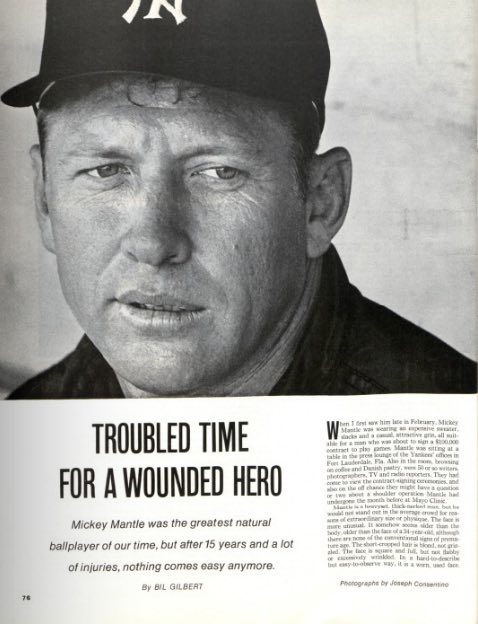Mickey Mantle: Troubled, Wounded Hero
This article and other features about baseball can be found in the Post’s Special Collector’s Edition, Baseball: The Glory Years. This edition can be ordered here.
Mantle is a heavyset, thick-necked man, but he would not stand out in the average crowd for reasons of extraordinary size or physique. The face is more unusual. It somehow seems older than the body, older than the face of a 34-year-old, although there are none of the conventional signs of premature age. The short-cropped hair is blond, not grizzled. The face is square and full, but not flabby or excessively wrinkled. In a hard-to-describe but easy-to-observe way, it is a worn, used face.
We stared at each other for a moment and then a strange look covered Mantle’s face — the Mantle Mask. The head sinks down on the shoulders, the eyelids are lowered, the mouth is closed tightly and the corners droop. All signs of inner feeling, interest, curiosity, even irritation and hostility disappear. The features go dead. Having put on the Mask, Mantle turned past an ordered hand and left the room.
In 1951, when Mantle came to the Yankees, he was nothing more or less than a small-town Oklahoma teenager. Yet almost immediately the boy was made into a famous man, more famous than most governors, congressmen, cabinet ministers. For 16 years, hundreds of strangers have been advancing on this man with outstretched hands and the same objective — to catch by force or ruse some part of him and bear it back triumphantly to a typewriter or microphone like a hunter. under these circumstances the Mask can be admired as a fairly sophisticated defensive device, like a porcupine’s quills, perhaps. Dealing with the Mask is somewhat like trying to open a clamshell barehanded.
— “Troubled Time for a Wounded Hero” by Bil Gilbert, Sept. 10, 1966
